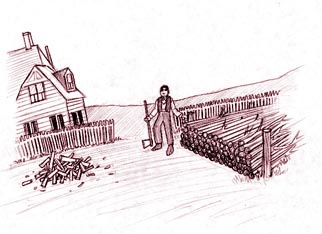The climate of the regions where residential schools were found, in combination with the fact that many of the schools were cheaply built, meant that vast amounts of fuel were needed even to maintain a tolerable temperature inside the buildings. Joe Dion claimed that at Onion Lake 'the greater part of our time outside of school hours was spent in sawing and splitting firewood; this was carried by the armful to the kitchen and sister's house, to the school and bakery.' Pictorial evidence makes it clear that even the younger school children were often pressed into service to gather wood and ready it for the stove.
Sawing logs for the furnace at the Sarcee boarding school in the 1890s
Other forms of outdoor work were more sporadic. For example, the demand for scrap metal created by the domestic industrial war machine during the Second World War provided a chance to generate some cash by collecting abandoned metalwork that could be sold. Such occasions were rare, but the principals' desire for revenue and their willingness to use students in an effort to produce it was a phenomenon found throughout the residential school system from the 1880s until the 1960s.



